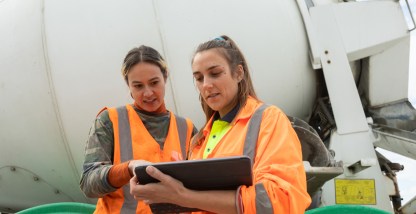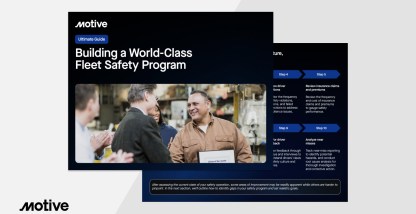Maintaining safe following distances plays a significant role in fleet driver safety, allowing all drivers to make good, well-planned decisions, reduce the risk of collisions, and improve overall safety on the road. All of this benefits your drivers and your fleet’s bottom line. This article shares best practices for commercial vehicles.
Learn about the Motive AI Omnicam for 360-degree visibility.
What is following distance?
Following distance is the distance between a vehicle and the vehicle in front of it. When one vehicle follows another too closely, it doesn’t matter how attentive the drivers are, there could still be a collision if the driver in front brakes suddenly.
It’s a component of a vehicle’s space cushion. The space cushion is not only how far ahead another vehicle is, but also how far back other drivers are. The goal is to have empty space around your vehicle at all times.
Keeping a safe following distance as part of the space cushion can help drivers to react in time to unsafe driving or other potential issues on the road. To be safe, you’ll need to know your stopping distance.
Calculating stopping distance
Safe following distance takes into account stopping distance, which consists of reaction distance and braking distance.
When a driver perceives a danger or need to stop, the time it takes to move the foot from the accelerator to brake is the driver’s reaction distance. Once the brakes are deployed, the vehicle will still travel some distance before coming to a complete stop. Road and weather conditions, vehicle speed and weight, and tire tread are among factors that can play a role in this distance — the braking distance.
Thus, stopping distance combines reaction and braking distance. Put another way, stopping distance = reaction distance + braking distance.
Now, we’ll explore how your following distance is determined and what the recommended minimum is for commercial vehicles.
Recommended minimum following distance for commercial vehicles
The recommended minimum following distance for a passenger vehicle will be different from the safe following distance for heavy-duty trucks. Yet the size and weight of your vehicle aren’t the only considerations when calculating how far back to stay from others on the road.
Factors that affect following distance
Leaving enough distance allows drivers time to see what’s happening on the road ahead, process that information, and react. Your total following distance is determined by several factors including:
- Vehicle size and weight. The larger and heavier your vehicle, the longer it takes for that vehicle to come to a complete stop. In ideal conditions, a typical passenger vehicle traveling 65 miles per hour takes 316 feet to stop. That’s about the length of a football field. A loaded tractor-trailer traveling that same speed, though, needs an average of 525 feet to stop (almost the length of two football fields).
- Speed. The faster your vehicle is traveling the more distance you need for safe following.
- Road conditions. Different road surfaces impact the following distance, as will debris on the road (such as oil).
- Weather conditions. Rain, ice, smog, and snow can all impact the distance needed for a vehicle to come to a complete stop.
- Traffic patterns. Not every road is a clear, level straightaway. Turns, inclines, and declines factor into following distance. The amount of traffic on the road also makes a difference as drivers have less room to maneuver in heavy traffic. Work zones are another place to increase your following distance for added safety.
- Driver traits. Every driver has a different reaction time depending on their age, vision, or skill.
Calculate the correct following distance for CMVs
You always need to be attentive on the road, but keeping sufficient distance helps improve your safety. One common approach to determine a safe following distance for trucks or other vehicles is to apply the Virginia Department of Motor Vehicle’s rule of seconds, which is:
“If you are driving below 40 mph, you should leave at least one second for every 10 feet of vehicle length. For a typical tractor-trailer, this results in four seconds between you and the leading vehicle. For speeds over 40 mph, you should leave one additional second.”
It probably takes longer to stop than you think. After all, your total stopping distance has three component parts:
- The distance traveled while you anticipate, decide, and act on a perceived hazard
- The distance traveled during your reaction to the hazard
- The distance traveled when you press the brake until the vehicle stops
How to maintain proper following distance
You can also maintain a safe following distance for semi-trucks or other commercial motor vehicles by adjusting your distance based on the conditions around you. In adverse conditions, the Federal Motor Carrier Safety Administration (FMCSA) recommends doubling your follow distance.
Drivers may also need to adjust the distance from the lead vehicle to account for weather conditions, visibility, and traffic. In emergency conditions, maintaining a safe distance can allow you to stop safely and/or take necessary evasive action.
Best practices for maintaining following distance
Commercial vehicle fleets can work to ensure drivers are keeping safe following distances. The following strategies can help.
Know safe following distance
Some commercial vehicle drivers also need to understand brake lag. Passenger vehicles typically have hydraulic brakes, which are faster. Yet, semi-trucks have air brakes. There’s a delay when semi-truck drivers hit the brakes, as air has to build up and reach everywhere on the truck to stop the wheels. Think of it like a garden hose: when you turn the nozzle the water has to travel through the hose before coming out the other end.
The difference in safe following distance for trucks may also be reflected in state law variations. If you’re driving across borders, it’s a good idea to confirm if there is a legal following distance requirement for trucks.
Use safety technologies
Technology is changing the trucking industry and playing an important part in improving road safety. The vehicle’s anti-lock braking system (ABS) can help the driver maintain control in an emergency situation.
An automatic emergency braking (AEB) system is an onboard technology that identifies possible collisions and activates the brakes to avoid a potential accident. This safety tool uses cameras, radar, and light detection and ranging (LiDAR) to act as an additional set of eyes on the road.
With dash cams and fleet safety management software, you’re able to alert your drivers in real time if they’re following too closely. AI-powered dash cam technology can notify drivers of the risk on the road. Managers can set it up so that they receive notifications as well. With Motive, you can follow up after the route is complete with automatic coaching in the Driver App.
Coach drivers
Train drivers on the importance of maintaining safe following distances and the consequences of not doing so. For example, this video of a CMV driver following too closely shows a near collision when the driver ahead slows to change lanes. It could be useful in a driver training session on following distance.
You can also educate drivers about best practices such as always scanning the road ahead, anticipating potential hazards, maintaining safe speeds, and avoiding distracted driving.
Using dash cams and fleet management software, safety managers can identify unsafe driving habits and offer individualized training.
Consequences of tailgating or following too closely
In addition to educating drivers about the meaning of following distance, it will help also to make sure they understand the possible consequences. Following too closely is a common moving violation for drivers of commercial vehicles. Tailgating or following too closely can also result in:
- Increased likelihood of collisions, which can result in property damage, injuries, and fatalities.
- Increased severity of collisions, as the force of impact is greater when vehicles are traveling at high speeds and following too closely.
- Legal repercussions. In addition to a ticket for driving too closely, drivers could also face charges for reckless or aggressive driving. Those charges can lead to a fine, jail sentence, and permanent criminal record.
- Increased insurance rates. Collisions and/or charges are going to prompt insurance companies to raise your premiums.
Beyond safety, the benefits of better driving habits
Following best practices helps drivers and improves overall road safety. But that’s not all. It can also have a positive impact on other factors that affect your fleet’s bottom line.
Driver retention
Driver recruitment and retention are real issues for commercial fleets. Yet, with increased driver safety, a fleet is more likely to retain its drivers. By taking a consistent coaching approach and offering dash cams, you can show your drivers that you care about their road safety.
That improved driver retention can also help with fleet safety by keeping your more experienced drivers on the road. So, it’s a win-win.
Improve productivity
Preventing accidents eliminates associated injuries and vehicle downtime. Driver job satisfaction also improves, which can motivate drivers to do their best work. With fleet vehicles in top condition, your workers can arrive on site, on time, and ready to go.
Lower costs
Better driving can lower fleet insurance rates and avoid costly fines or legal fees. A better safety record can also help fleets win more business, which can help optimize route efficiency to lower costs. At the same time, you don’t have to deal with downtime for crash investigations or the costs of collision repairs.
Increase fleet safety with the Safety Hub and driver coaching
Knowing how following distance is determined and the value of safe distances for all vehicles can protect your drivers, your business, and others on the road.
Don’t underestimate the power of coaching coupled with safety technology to encourage continuous learning and improve your productivity and profitability.
Motive’s Safety Hub is designed to help fleets identify risks and prevent accidents. If you have a Pro or Enterprise subscription, reach out today to learn more.










